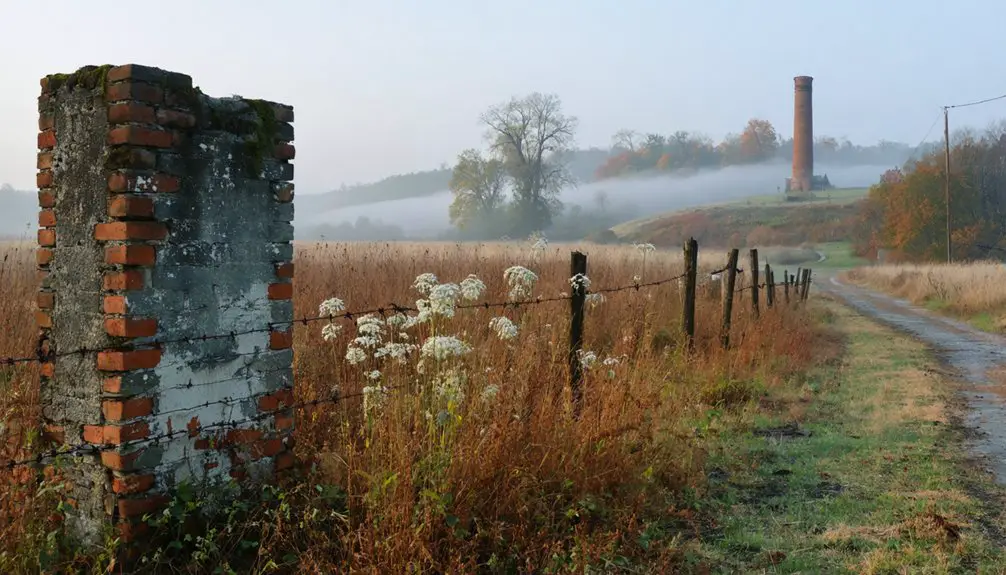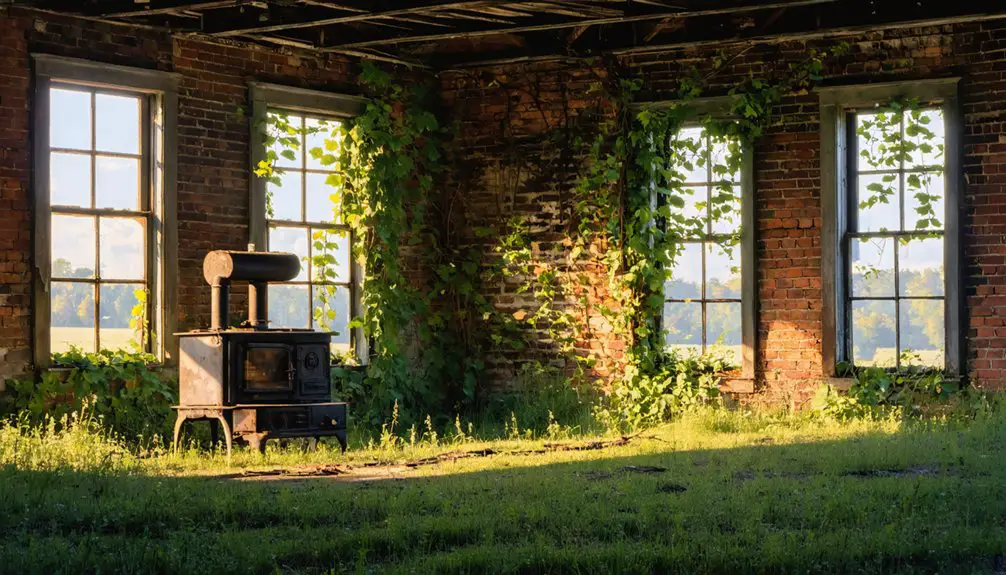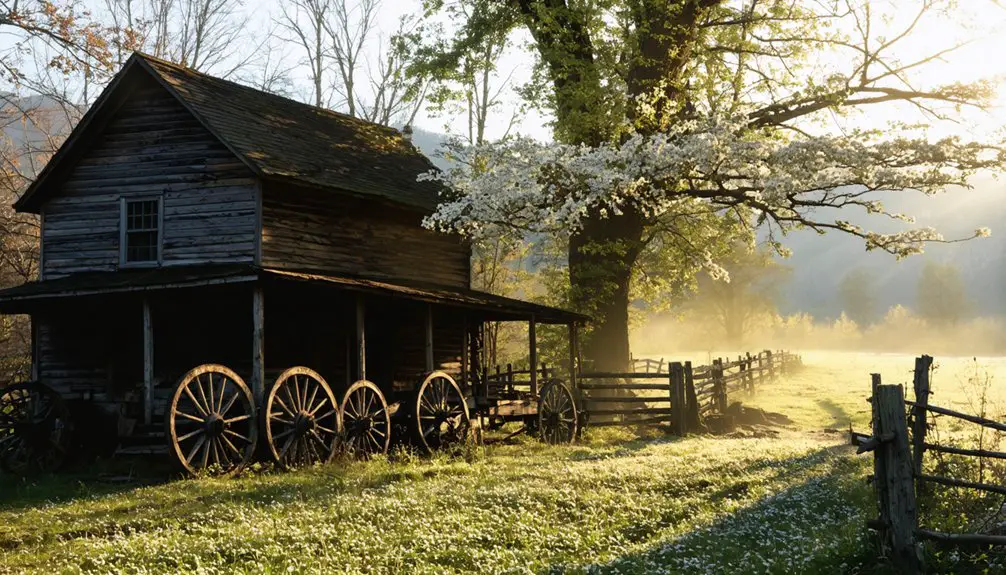You’ll find Hopewell, Tennessee at 35.2349°N, 84.9052°W, where it once thrived as a Cherokee settlement and pioneer town. In 1824, the Candy’s Creek Cherokee Mission established the area’s first church and post office, serving as a cultural bridge between settlers and natives. The community flourished until 1838, when the Trail of Tears forced nearly 17,000 Cherokee to leave. Today, abandoned streets, limestone ruins, and archaeological sites reveal Hopewell’s complex story beneath its quiet surface.
Key Takeaways
- Abandoned streets in Hopewell contain limestone-constructed public buildings and storefronts, with original sidewalks outlining former pedestrian routes.
- Archaeological findings reveal a 400-acre Middle Woodland mound complex with 13 ceremonial mounds dating from 100 B.C. to A.D. 400.
- The town served as the site of Bradley County’s first church and post office before becoming deserted after the Cherokee Removal.
- Historical markers throughout Hopewell document lost structures, municipal buildings, and the community’s rich cultural history.
- Protected cemeteries and memorial sites provide tangible connections to former residents and the town’s historical significance.
Early Settlement and Cherokee Origins
Before the Treaty of Hopewell in 1785, the Cherokee people maintained a vast territory spanning from northern Tennessee into the Carolinas and Georgia, where they established more than sixteen towns east of the Blue Ridge Mountains.
You’d find thriving Cherokee settlements along the Little Tennessee River, where the “Overhill” towns served as cultural centers for their complex society of farmers, hunters, and traders.
Despite the treaty’s terms, many white settlers ignored eviction orders and continued to expand their land claims in Cherokee territory.
Everything changed when the Treaty of Hopewell redrew the boundaries. The agreement ceded land south of the Cumberland River near Nashville to white settlers and marked the end of Cherokee-US fighting.
While the treaty promised to protect remaining Cherokee lands, subsequent agreements like the Treaty of Holston in 1791 further reduced their territory east of Clinch River, forever altering the region’s cultural landscape. The treaty negotiations took place at General Andrew Pickens’ plantation in South Carolina over a 45-day period.
The Birth of Candies Creek Mission
Deep in the Cherokee Nation territory of present-day Bradley County, Tennessee, the Candy’s Creek Cherokee Indian Mission Station emerged in 1824 as a pioneering Christian outpost.
The mission founding was spearheaded by Samuel Worcester and five companions, who recognized the area’s significance near a Cherokee village along Candy’s Creek – named for Henry Candy, an 1817 settler.
In February 1825, William and Electra Holland from Brainerd Mission joined the effort, strengthening the mission’s early influences.
You’ll find it remarkable that this establishment wasn’t just a church – it served as the area’s first post office and included a school that educated thirty Cherokee pupils by 1828.
The mission became one of several that would dot the Cherokee landscape, marking the beginning of organized Christian outreach in this essential frontier region.
After 14 years of service to the community, the mission was forced to close in 1838 after Cherokee Removal.
Community Life and Religious Development
As settlers and Cherokee inhabitants formed bonds in early Hopewell during the 1820s, religious life emerged as the cornerstone of community development.
You’ll find that the Candy’s Creek Presbyterian Church, established in 1825, became the heart of cultural interaction between European Americans and Cherokee people. The mission church didn’t just offer worship services – it served as the central meeting place where both groups participated in community governance through church sessions. Like many geographic locations named Hopewell, this Tennessee settlement embraced its multicultural identity through shared spiritual traditions. Similar to the Hopewell Hebrew Congregation established nearly a century later in Virginia, the church became a pillar of community leadership and cultural preservation.
Candy’s Creek Church transcended worship, becoming a sacred space where settlers and Cherokee people united in faith and governance.
The religious foundation extended beyond Sunday gatherings.
In February 1825, the mission school opened its doors, combining Christian teachings with general education. You would’ve witnessed Cherokee students learning alongside settler children, while Presbyterian missionaries like Samuel Worcester and William Holland fostered a unique environment where two cultures blended through shared faith and learning.
Notable Cherokee Leaders and Education
You’ll find that early Cherokee mission schools in Hopewell played a crucial role in educating future tribal leaders during the pre-removal period of the 1820s.
Mission graduates went on to serve in key positions within the Cherokee National Council, with several becoming influential voices in treaty negotiations with the U.S. government. The council’s structure included peace and war chiefs who helped shape tribal policies. This education model proved especially valuable for leaders like Principal Chief Ross, who received formal schooling to understand both Cherokee and American cultures.
The mission’s emphasis on bilingual education helped create a generation of Cherokee leaders who could effectively advocate for their people’s interests while maintaining their cultural identity.
Cherokee Mission Education Leaders
While Cherokee education underwent significant changes in the early 19th century, several missionary leaders emerged as influential figures in shaping formal Native American schooling.
You’ll find that Gideon Blackburn pioneered the movement in 1803, establishing schools for Cherokee children through both government and private funding. The largest institution, Brainerd Mission, began in 1817, inspired by David Brainerd’s earlier work. Students were initially charged one dollar per week to attend the school.
Key Cherokee educators like Samuel Worcester, Ainsworth Blunt, and Cephas Washburn brought their missionary influence to Brainerd, operating under the American Board of Commissioners for Foreign Missions. The mission provided students with extensive training in vocational skills and crafts, including smithing, carpentry, and weaving.
These leaders shaped education by implementing the Lancaster teaching model, where older students taught younger ones. Their work, though controversial for its cultural impact, created a foundation for English literacy among Cherokee leaders and facilitated political engagement with American institutions.
Prominent Mission School Graduates
The missionary education system produced several notable Cherokee leaders who shaped their nation’s future direction.
At Brainerd Mission School, established in 1817, Catharine Brown emerged as one of the first Cherokee students to achieve remarkable mission school achievements. She mastered English literacy within three months and became the school’s first Cherokee missionary teacher.
Elias Boudinot, educated at mission schools in Georgia and Connecticut, became a transformative figure through his role as editor of the Cherokee Phoenix, the first Native American newspaper.
You’ll find that these graduates served as essential bridges between Cherokee traditions and European-American influences. Female graduates like Brown played significant roles in spreading literacy and Christian values throughout Cherokee communities, fundamentally changing their society’s educational landscape.
Geographic Landscape and Natural Features

Situated at 35.2349°N latitude and 84.9052°W longitude, Hopewell occupies a gently rolling landscape within Bradley County, Tennessee. At 722 feet elevation, you’ll find this 7.1-square-mile area characterized by a mix of open farmland and scattered woodland patches.
The natural terrain belongs to the Appalachian Ridge-and-Valley province, which shapes the local soil composition and drainage patterns. As you explore the landscape features, you’ll discover small creeks weaving through the countryside, while patches of forest dot the agricultural fields.
The western section holds denser woodland, where you can spot remnants of old mill foundations. Despite modern development creeping in from nearby Cleveland, Hopewell’s geographic character remains distinctly rural, with its network of country roads following the natural contours of the land.
The Impact of Cherokee Removal
During the 1830s, Hopewell’s landscape bore witness to one of America’s darkest chapters as thousands of Cherokee people were forcibly removed from their ancestral lands.
The area became a vital point along the infamous Trail of Tears, where Cherokee resilience was tested against harsh winter conditions and government-mandated displacement.
- Nearly 17,000 Cherokee and their African American associates were forced through Hopewell’s terrain.
- Local witnesses observed countless families struggling through freezing temperatures and snowstorms.
- Cultural displacement shattered traditional Cherokee governance and community bonds.
- Hopewell’s paths echoed with the footsteps of those who’d never return, as approximately 4,000 Cherokee perished during the journey.
The removal transformed Hopewell from a place of Cherokee heritage into a silent reflection of survival against overwhelming odds.
Archaeological Findings and Cultural Heritage
Modern archaeological discoveries have revealed Hopewell’s rich history beyond its Trail of Tears connection, disclosing an expansive 400-acre Middle Woodland mound complex that once served as a major ceremonial center.
Archaeological research unveils Hopewell’s ceremonial legacy through a vast 400-acre complex of Middle Woodland mounds, transcending its Trail of Tears past.
The site’s archaeological significance spans from 100 B.C. to A.D. 400, featuring 13 mounds including the impressive Sauls Mound.
You’ll find evidence of extensive cultural connections through artifacts like Flint Ridge bladelets from Ohio, copper plates, and pearl-adorned bear teeth.
The discovery of ritual spaces and exotic materials from regions as distant as Illinois and Georgia proves Pinson Mounds’ role as a major pilgrimage destination.
Mitochondrial DNA studies of Hopewell burials reveal complex population interactions, while ceramic evidence suggests the site’s ceremonial activities declined around A.D. 350, leading to its eventual abandonment.
Lost Landmarks and Historical Markers
While walking through Hopewell’s abandoned streets today, you’ll encounter scattered remnants of its once-thriving community, including limestone-constructed public buildings and weathered commercial storefronts from the 19th and early 20th centuries.
Historical markers tell the story of these lost structures, with each site revealing a piece of Hopewell’s past.
- Original sidewalks and alleyways map out the town’s bustling pedestrian routes, offering glimpses into daily life before abandonment.
- Official markers highlight the historical significance of former municipal buildings and post offices that served as community hubs.
- Surviving buildings showcase architectural adaptations, with upper-level doorways and modified entrances telling stories of changing times.
- Protected cemeteries and memorial sites provide tangible connections to former residents, complete with revealing inscriptions and family histories.
Legacy in Tennessee History
Beyond the physical remnants of Hopewell’s buildings lies a rich historical legacy that shaped Tennessee’s early development.
You’ll find the town’s influence in the establishment of Bradley County’s first church and post office, marking the beginnings of organized community infrastructure in the region.
The story of Hopewell captures a pivotal moment of cultural exchange between European settlers and Cherokee natives, particularly through Candy’s Creek Mission‘s educational work with future Cherokee leaders.
Though the forced removal of the Cherokee in 1838 ended this period of interaction, the mission’s impact endures through historical preservation efforts.
Despite losing some historical markers in the 1980s, Hopewell’s significance lives on through archaeological studies and scholarly work, reminding you of Tennessee’s complex journey from indigenous territory to settled state.
Frequently Asked Questions
What Happened to the Original Church Building After the Mission Closed?
Like a time capsule on Facebook, you’ll find the church preserved at Camp Hopewell since 1951. Community memorials and preservation efforts saved the 1849 structure after the mission’s closure in 1981.
Are There Any Descendants of the Mission’s Students Still Living Nearby?
You won’t find documented descendant stories or verified community connections from mission students nearby today, as most Cherokee families were forced to relocate during the 1838 removal to Oklahoma.
What Specific Crops Were Grown by Early Settlers in Hopewell?
Like waves of gold, early settlers cultivated corn as their primary crop around A.D. 175, alongside beans and squash. You’ll find they also grew tobacco, sunflowers, gourds, and native seeds like goosefoot.
Were There Any Documented Conflicts Between Missionaries and Local Cherokee Leaders?
You’ll find missionary relations were tense but rarely violent, marked by Cherokee resistance through council resolutions opposing land sales and cultural changes, while some missionaries like Elizur Butler maintained long-term peaceful coexistence.
How Did Local Weather Patterns Affect the Mission’s Operations and Settlement?
You’ll find Mother Nature’s moods deeply shaped daily life, as weather impacts brought seasonal challenges through flooding, harsh winters, and summer heat, affecting farming, school attendance, and settlement infrastructure.
References
- https://en.wikipedia.org/wiki/Hopewell
- https://www.tnmagazine.org/19-ghost-towns-in-tennessee-that-are-not-underwater/
- https://www.ohiohistory.org/pinson-mounds-a-hopewell-pilgrimage-center/
- https://en.wikipedia.org/wiki/Hopewell_tradition
- https://www.hauntedplaces.org/hopewell-tn/
- https://en.wikipedia.org/wiki/Treaty_of_Hopewell
- https://sevier.tngenealogy.net/about-sevier/44-history/155-sevier-county-settlers-vs-the-cherokee-indians
- https://www.digitalhistory.uh.edu/active_learning/explorations/indian_removal/removal_timeline.cfm
- https://tennesseeencyclopedia.net/entries/treaties/
- https://en.wikipedia.org/wiki/Historic_Cherokee_settlements



